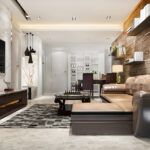When it comes to interior design, drapery is more than just a window covering — it’s a statement of style, a layer of texture, and a key element in setting the mood of your space. Choosing the right fabric for your custom drapery is essential to achieving the perfect balance of function and beauty. At MAYFAIR, we guide clients through this process every day, ensuring their choices enhance the space both aesthetically and practically.
In this blog, we’ll walk you through the most important considerations when selecting the perfect drapery fabric for your home or project.
1. Understand the Purpose of the Drapery
The first step is to define the function of your drapery:
-
Do you need privacy in a bedroom or bathroom?
-
Are you looking to block out light for a restful sleep?
-
Do you want to filter sunlight while keeping the room bright and airy?
-
Is your main goal style enhancement?
Once the function is clear, it becomes easier to choose a fabric that supports that purpose. For example, heavier fabrics like velvet or blackout-lined cotton are excellent for privacy and light control, while sheer fabrics like voile or organza are ideal for a soft, breezy look.
2. Choose the Right Fabric Weight
Fabric weight plays a major role in the drape and fall of the curtains:
-
Lightweight fabrics (e.g., linen, sheers, cotton blends) offer softness and movement. They’re ideal for casual spaces, open-plan living areas, or as layering behind heavier curtains.
-
Medium-weight fabrics (e.g., poly-cotton blends, brocades, silk) are versatile and work well in most rooms. They provide structure while maintaining elegance.
-
Heavyweight fabrics (e.g., velvet, jacquard, wool blends) offer maximum insulation, block light effectively, and add a sense of luxury and formality.
Your choice depends on both aesthetics and how the fabric will perform over time in your environment.
3. Consider Light and Room Orientation
How much natural light enters your space should impact your fabric decision. South-facing rooms with strong sun exposure may require UV-resistant or lined fabrics to prevent fading. In darker rooms, lightweight and light-colored fabrics help brighten the space.
Also consider whether your drapery will frame a view or provide full coverage. Transparent and semi-transparent fabrics are ideal if you want to keep an open view while softening harsh light.
4. Align with Your Interior Style
Your fabric choice should complement your room’s overall design. Here are a few common pairings:
-
Modern & Minimalist: Clean lines, neutral tones, solid colors, or simple geometric prints in cotton, linen, or voile.
-
Traditional & Elegant: Rich textures like silk, brocade, and velvet in jewel tones or intricate patterns.
-
Coastal & Casual: Breezy cottons, linens, and sheers in light, natural shades like whites, blues, and sandy neutrals.
-
Eclectic & Bold: Vibrant prints, layered textures, and mixed materials.
Fabric acts like a canvas for the rest of the room — make sure it complements furniture, wall color, flooring, and decorative accents.
5. Select the Right Color and Pattern
Color can dramatically affect the mood and perception of space:
-
Light colors expand the space and create an airy, calming feel.
-
Dark colors add drama, intimacy, and warmth.
-
Bright colors or bold patterns can act as a focal point or complement your accent pieces.
Patterned fabrics add personality but may feel overwhelming in smaller spaces or cluttered rooms. If you already have a lot of prints, consider solid or subtle textured fabrics to bring balance.
6. Think About Fabric Care and Maintenance
Some fabrics require more maintenance than others:
-
Silk: Luxurious, but delicate and prone to sun damage — best for low-light rooms or with protective lining.
-
Cotton and linen: Natural and breathable, but may wrinkle or shrink if not treated.
-
Polyester blends: Durable, wrinkle-resistant, and easy to clean — great for everyday living areas.
-
Velvet: Rich in texture, but may attract dust and need professional cleaning.
Ask your workroom or designer about care instructions so you can choose something that fits your lifestyle.
7. Don’t Skip the Lining
A quality lining can extend the life of your fabric, improve insulation, and control how light interacts with the fabric. At MAYFAIR, we recommend:
-
Blackout lining for bedrooms and media rooms
-
Thermal lining for heat and sound insulation
-
Standard lining for structure and light filtering
-
Interlining for added weight, fullness, and luxury
It’s an investment that elevates the performance and appearance of your custom drapery.
8. See and Feel the Fabric in Person
Never choose a fabric based on photos alone. Lighting, screen calibration, and fabric movement are hard to judge digitally. At MAYFAIR, we encourage all clients to see and feel fabric swatches before making a final choice.
We also offer expert design consultations where we help compare textures, colors, opacity, and drape — making it easier to visualize how the fabric will look in your space.
Final Thoughts: Choose with Confidence
Custom drapery is a long-term investment in your space. It’s not just about beauty — it’s about functionality, comfort, and personality. When you work with MAYFAIR, you’re not just choosing fabric; you’re designing an experience that’s tailor-made for your lifestyle.
Our team is here to guide you every step of the way — from inspiration and selection to fabrication and installation.




